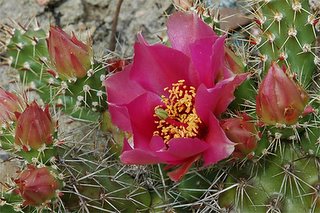
Echinocereus triglochidiatus var. mojavensis flower
Echinocereus triglochidiatus var. mojavensis flower, close-up
Last summer my Echinocereus triglochidiatus var. mojavensis (SB 1756; Montrose County, Colorado, USA) flowered for the first time.
Flowering Echinocereus triglochidiatus var. mojavensis
The plant is growing outdoors all year round, with some protection from precipitation during winter.
The flower is absolutely stunning and I almost can't wait for the plant to form a large mound covered in flowers.
Monday, February 02, 2009
Flowering Echinocereus triglochidiatus var. mojavensis (Mojave Kingcup Cactus)
Tuesday, December 30, 2008
Flowering Titanopsis calcarea
I bought my first Titanopsis calcarea plants (SB 1111; Magersfontein, Kimberley, South Africa) this summer and they have been growing in my unheated greenhouse since. I'd read that T. calcarea flower in late fall and winter but have to admit I was a bit surprised to see a flower on December 22, one day after the winter solstice.
Flowering Titanopsis calcarea – close-up
The orange/bronze colored flower looks beautiful illuminated by the low winter sun. I'm fascinated by the rosettes of blue-green, white tipped leaves with grayish white tubercles – the species name calcarea means “of or pertaining to limestone”, i.e. looking like limestone.
Flowering Titanopsis calcarea (SB 1111; Magersfontein, Kimberley, South Africa)
T. calcarea clumps readily, forming dense succulent mats with age.
The plants were bought from Kakteen-Haage.
Saturday, September 15, 2007
Flowering Conophytum sp.
I have no previous experience growing Conophytum but last year I fell for a nice specimen of the genus and it’s now growing in my coldhouse. Conophytum is a typical winter-grower – in habitat it’s distributed in the arid winter rainfall areas from southern Namibia to the western part of South Africa. Consequently Conophytum must be treated fundamentally differently to cacti.
Flowering Conophytum sp. – close-up
Conophytums must have a summer resting period, during which the existing leaves dry up to papery sheaths that protect next season’s budding leaves. Watering is resumed in late summer and new leaves develop rapidly, tearing apart the protective sheath formed by the old leaves. The plants should be watered quite heavily during the growth period; flowers are usually also produced during this period. When autumn sets in watering must be greatly reduced or completely stopped.
Flowering Conophytum sp.
In spite of my lack of experience in growing plants from this genus, my Conophytum sp. rewarded me with two flowers a couple of days ago. I have no clue what species my plant is, but it seems to be standing the cold quite well (apparently frost-free conditions are recommended for Conophytums in general).
If anyone can decide the species based on the photos I would very much like to know. Also recommendations of other Conophytum species that can be grown under unheated glass (in freezing environments) would be greatly appreciated.
Wednesday, August 15, 2007
Flowering Opuntia tortispina
Back in 2004 I ordered a batch of plants from Uhlig-Kakteen in Germany including two Opuntia tortispina (DJF 1139; west Albuquerque, New Mexico). The plants arrived in late summer and spent their first winter outdoors in a large pot placed near a south facing wall. In 2005 one of the plants was transplanted to an unprotected bed; this plant flowered for the first time this summer but unfortunately the flowers never unfolded completely because of rainy and overcast weather.
Opuntia tortispina flower
My unprotected beds are located in the northern parts of Denmark only a couple hundred meters (yards) from the North Sea and the plants are often exposed to strong, salty westerlies. Most of my plants seem to thrive in these conditions with O. tortispina as one of the exceptions – it grows slowly and has orange-brown, barky patches on all cladodes.
Opuntia tortispina in unprotected bed
The plant still growing in the pot protected by a house wall is more than double in size, and all cladodes are an immaculate green; on the other hand this plant never flowered ;-) Unfortunately I forgot to take pictures for comparison.
You can find details on other Opuntia plants that flowered in the summer of 2007 in these posts: Opuntia fragilis (Butte Co, Nebraska), Opuntia polyacantha, Opuntia 'Claude Arno'.
Tuesday, July 17, 2007
Opuntia 'Claude Arno' flowering in the rain
Usually my Opuntias are displaying a wealth of flowers at this time of year, but it’s been raining for weeks now in Denmark, holding the flowers back. The wet weather was preceded by a hot and sunny period resulting in a lot of flower buds; unfortunately many of these will end up as “duds” because of the rain.
Luckily some plants like Opuntia 'Claude Arno' are insisting on flowering even though the chances for being visited by pollinating insects are slim in this weather.
Opuntia 'Claude Arno' flowering in the rain, close-up
Still the plants look pretty miserably in the rain with only half-opened flowers.
Opuntia 'Claude Arno' flowering in the rain
The wet weather has one other unfortunate side effect: hordes of snails and slugs are stampeding through my beds causing havoc for new growth, flower buds, and other tender parts of the plants. The day after the above photos were taken the sun shone, giving the flowers a chance to open fully – to no avail though as most anthers had been shaven off of the stamens, by gastropods I presume.
Opuntia 'Claude Arno' missing anthers
Fortunately I haven’t seen any traces of the Iberian slug (Arion lusitanicus) that has spread up through Europe and is now thriving in the Scandinavian climate to such a degree that it’s nick-named the “killer slug”.
You can find details on other Opuntia plants that flowered in the summer of 2007 in these posts: Opuntia fragilis (Butte Co, Nebraska), Opuntia polyacantha, Opuntia tortispina (Albuquerque, New Mexico).
Tuesday, June 26, 2007
Flowering Opuntia polyacantha
Last year I didn’t experience a single of the many flowers set by my Opuntia polyacantha. Fortunately a visit to my summerhouse (where my winter hardy cacti beds are located) coincided with the flowering of the Opuntia polyacantha this summer.
Opuntia polyacantha flower, close-up
The plant is growing in the middle of my oldest cactus bed and soon needs pruning – otherwise it will spread into the neighboring Opuntia 'Smithwick' and Opuntia humifusa plants (seen respectively in the front and background of the below picture). The wild poppies also have to go; I found them charming when small but now they are taking up too much space.
Opuntia polyacantha in cactus bed
Like Opuntia humifusa flowers the flowers of Opuntia polyacantha are popular with bumble bees.
Bumble bee indulging in the pleasures of pollen and nectar
Even the slightly spent flowers from the day before are fancied by the bees.
Bumble bee leaving a flower
You can find details on other Opuntia plants that flowered in the summer of 2007 in these posts: Opuntia fragilis (Butte Co, Nebraska), Opuntia 'Claude Arno', Opuntia tortispina (Albuquerque, New Mexico).
Flowering Opuntia fragilis
Many of my Opuntia plants are flowering early this year including one of my favorites, Opuntia fragilis (Butte Co, Nebraska) with beautiful yellow, red-tinted flowers displaying red filaments, yellow anthers, and green stigma lobes. 
Opuntia fragilis flower, close-up
Last year the plant was moved to a new bed resulting in very few flowers. Now the plant has settled into its new location and the old growth is budding with flowers.
Opuntia fragilis at its new location
Opuntia fragilis, flower buds
You can find details on other Opuntia plants that flowered in the summer of 2007 in these posts: Opuntia polyacantha, Opuntia 'Claude Arno', Opuntia tortispina (Albuquerque, New Mexico).
Thursday, June 14, 2007
Delosperma – early flowers, take 3
Delosperma 'John Proffit' is flowering as the last of my Delosperma plants, displaying a wealth of attractive purple flowers with bright white centers.
Delosperma 'John Proffit', close-up
Delosperma 'John Proffit' is a vigorous, almost aggressive, grower. The plant has taken over a good part of one of my cactus beds, leaving a Cylindropuntia viridiflora stranded in a sea of purple flowers.
Sprawling Delosperma 'John Proffit'
For an illustration of the prolific growth you can compare the above plant with the same plant 10 months ago.
Tuesday, May 29, 2007
Delosperma – early flowers, take 2
As mentioned in the previous post my Delosperma plants are currently flowering. The latest addition to the flower feast is Delosperma nubigenum (Sani Pass, 2900m, Lesotho) boasting buttery yellow flowers.
Delosperma nubigenum (Sani Pass, Lesotho), close-up
The plant is forming a compact mat and has – like my other Delosperma plants – grown considerably in the year I’ve had it.
Delosperma nubigenum (Sani Pass, Lesotho)
Last week the Delosperma sp. (Sani Pass, Lesotho) plant was completely hidden by flowers; most of these have withered and the plant is now visible again._20070526.jpg)
Delosperma sp. (Sani Pass, Lesotho)
Since last week the Delosperma sp. (Drakensberg) plant has unfolded all its flower buds and now forms a carpet of purple flowers._20070526.jpg)
Delosperma sp. (Drakensberg)
Now I’m just waiting for my Delosperma 'John Proffit' to flower.
Tuesday, May 22, 2007
Delosperma – early flowers
As mentioned in a previous post I’m a Delosperma novice and consequently hadn’t expected the plants to be flowering this early, but two of the species I’m growing flowered abundantly this weekend (I’m not sure if it’s a coincidence or a pattern but my other two species flowered very late last autumn)._close-up_20070517.jpg)
Delosperma sp. (Sani Pass, Lesotho), close-up
The Delosperma sp. (Sani Pass, Lesotho) plant is completely hidden by flowers – I’m curious if it can keep up this pace during summer, or if it will be all spent in a couple of weeks._20070517.jpg)
Delosperma sp. (Sani Pass, Lesotho)
The Delosperma sp. (Drakensberg) is currently flowering along the edges of the plant but flower buds abound everywhere on the plant, so maybe it’s just a matter of time before this one will be completely covered in flowers as well._20070517.jpg)
Delosperma sp. (Drakensberg)_close-up_20070517.jpg)
Delosperma sp. (Drakensberg), close-up
Saturday, March 03, 2007
Flowering Escobaria sneedii
Last summer my Escobaria sneedii (SB 173; Doña Ana County, New Mexico) plants flowered for the first time.
Flowering Escobaria sneedii
The E. sneedii plants are heavily branching, eventually forming large clusters. The stems are obscured by a dense cover of bright snowy white spines, and the flowers are a pale rose-pink with slightly darker midstripes.
The plants are grown in a coldhouse and are exposed to temperatures well below freezing during winter. They are allegedly very rot-prone, so I grow them in an inorganic, mineral soil with extremely good drainage. The plants are kept bone-dry during winter but watered rather freely during their growing season. 
Flowering Escobaria sneedii – top view
I bought the plants from Mesa Garden during a visit to the US a couple of years ago.
Escobaria sneedii is also known as Coryphantha sneedii.
Saturday, September 30, 2006
Delosperma – late flowering
I know this post is a bit out of context, but the Delosperma plants are growing among my winter hardy cacti so that ought to give it some relevance ;-)
Having passed the autumnal equinox I hadn’t expected any flowers from the Delosperma plants – nevertheless two of them are still displaying a few.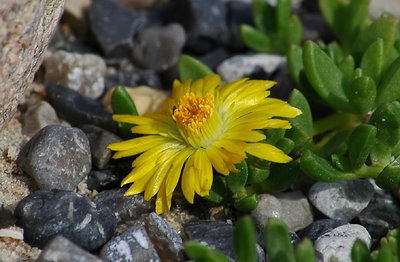
Delosperma nubigenum
Delosperma nubigenum (hardy yellow ice plant) has a vigorous carpeting growth habit with succulent and evergreen foliage. The foliage is supposed to have a bright red winter color (this is my first season growing Delosperma so I can’t say for sure). The plant has been flowering all through summer, except for the hottest periods.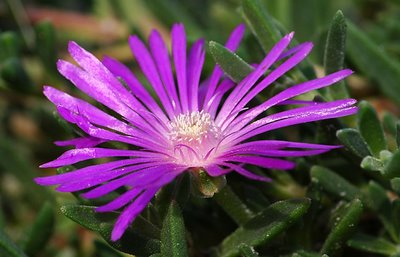
Delosperma 'John Proffit'
The prolific Delosperma 'John Proffit' almost exploded with growth during summer and grew a lot of flowers. I’m intrigued by the bright center of the flowers almost illuminating them from within when basking in the sun.
As mentioned I haven’t grown Delosperma before, so I’m a bit excited to see how (and if) they make it through winter.
Sunday, September 03, 2006
Flowering Opuntias – Summer 2006
A handful of my winter hardy Opuntias flowered this summer. In separate posts you’ll find details on O. humifusa, O. ‘Claude Arno’, and O. fragilis.
I’m growing my plants at a summerhouse which unfortunately means that I’m often missing a flower or two. This year I didn’t experience a single of the many flowers on my Opuntia polyacantha.
Opuntia polyacantha with spent flowers
Last year I posted a photo of the flowering Opuntia polyacantha.
Flowering Opuntia humifusa
This summer my Opuntia humifusa set out on a flowering spree with loads of yellow flowers.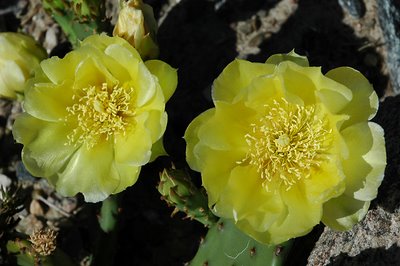
Flowering Opuntia humifusa
Initially the pure pale-yellow flowers didn’t appeal much to me, but I have to admit the “monochrome” flowers grow on you after a while.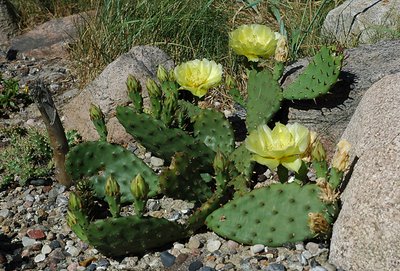
Opuntia humifusa plant
The bumble bees also seem to enjoy the flowers, virtually diving into them in their search for nectar and pollen.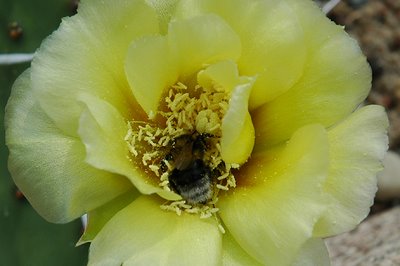
Bumble bee enjoying an O. humifusa flower
Go to the overview of Opuntias flowering in 2006.
Flowering Opuntia ‘Claude Arno’
Opuntia ‘Claude Arno’ did it again – like last year it displayed a wealth of pink flowers this summer.
Flowering Opuntia ‘Claude Arno’
The rosy red flowers with the pearly sheen are one of my girlfriend’s favorites. She’s usually not into cacti but has a hard time resisting the pink charm of Claude Arno ;-) 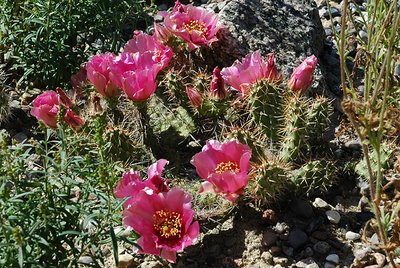
Opuntia ‘Claude Arno’ plant
Go to the overview of Opuntias flowering in 2006.
Flowering Opuntia fragilis
With its dark green pads and reddish-brown spines the Opuntia fragilis (Butte Co, Nebraska) plant is beautiful in itself, but the yellow flowers, tinted red basally, with its red filaments, yellow anthers, and green stigma lobes are absolutely stunning.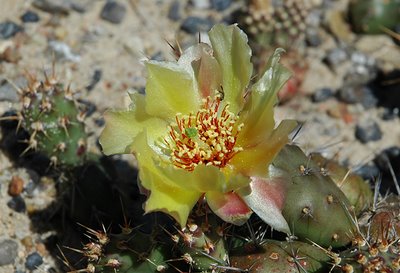
Opuntia fragilis flower
The plant only set a handful of flowers this summer, which was a bit disappointing compared to last years bombastic display. I suspect it’s related to the plant being transplanted in the spring.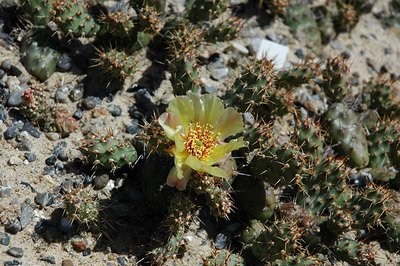
Group of Opuntia fragilis plants
Go to the overview of Opuntias flowering in 2006.
Sunday, August 13, 2006
Delosperma 'John Proffit'
Early this summer I planted a Delosperma 'John Proffit' among my winter hardy cacti. It’s a prolific grower and has been flowering most of the summer.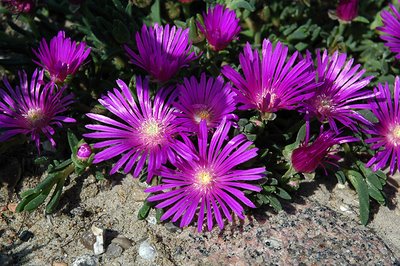
Delosperma 'John Proffit'
Allegedly Delosperma 'John Proffit' is cold hardy in Denmark – I’m hoping it survives the coming winter.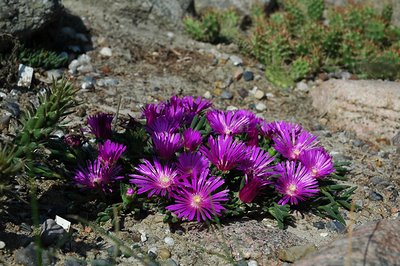
Delosperma 'John Proffit' growing among cacti
Monday, March 20, 2006
Opuntia 'Claude Arno'
The second installment in the I-wish-it-would-be-summer-soon photo series features a flowering Opuntia 'Claude Arno'. The flowers are a distinct rosy red with a pearly sheen.
Opuntia 'Claude Arno' flower close-up
I bought the plant as a cutting from Bennys Kaktus a couple of years ago and it flowered for the first time last summer. According to Benny this cultivar is a hybrid of Opuntia fragilis and Opuntia polyacantha var. rhodantha.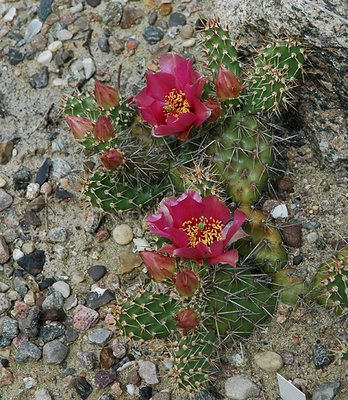
Flowering Opuntia 'Claude Arno'
The pictures can also be seen as a fitting celebration of today’s vernal equinox ;-)
Monday, March 06, 2006
Cylindropuntia whipplei
While waiting for the return of summer I’ll post a handful of photos of plants that flowered last year. I'll start with my Cylindropuntia whipplei (MUG 125; 2100m, San Juan, New Mexico) that flowered for the first time even though it’s still young and far from being the compact shrub described in the Flora of North America.
Cylindropuntia whipplei flower
The flowers are a beautiful green-yellow and develops on the upper part of the stem segments.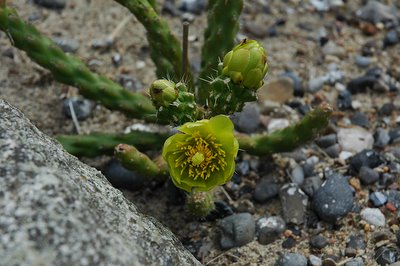
Flowering Cylindropuntia whipplei
I’m a bit worried if the plant will make it through winter – last time I checked some of the stem segments seemed to be rotting. I hope the damage is located to individual segments and will not spread to the whole plant.

